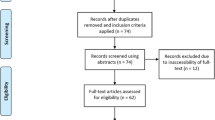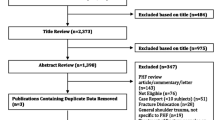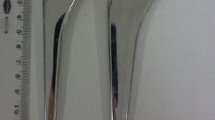Abstract
Purpose
Experimental in vitro studies investigating periprosthetic fractures after joint replacement are used increasingly. The purpose of this review was to deliver a condensed survey of studies in order to provide researchers with an overview of relevant scientific results and their clinical relevance.
Methods
A literature search was conducted to obtain all available papers dealing with periprosthetic fractures, with particular attention being paid to articles with an experimental research design. Study goals, scientific methods and results, their interpretation and clinical relevance were assessed and compared. The main focus was on comparability with clinical fracture patterns and physiological joint loads.
Results
Excluding duplicates, 24 studies with regard to artificial hip, knee and shoulder joints were found dating back to August 2000. Almost all studies were performed quasi-statically and without consideration of muscle forces and thus reflect selected loading conditions and no dynamic situation during activities of daily living (ADL). Various experimental protocols were used, differing in the choice of experimental material, implant and fixation system and load application.
Conclusions
In vitro studies regarding periprosthetic fracture research allow controlling for disturbances, such as clinically occurring risk factors like reduced bone mineral density (BMD) or greater patient age. Notwithstanding, due to methodological differences, comparisons between studies were possible to a limited degree only. For this reason, and because of quasi-static loading typically applied, results can only be partially applied to clinical practice.

Similar content being viewed by others
References
Johansson JE, McBroom R, Barrington TW, Hunter GA (1981) Fracture of the ipsilateral femur in patients wih total hip replacement. J Bone Joint Surg Am 63:1435–1442
Lindahl H, Malchau H, Herberts P, Garellick G (2005) Periprosthetic femoral fractures: classification and demographics of 1049 periprosthetic femoral fractures from the Swedish National Hip Arthroplasty Register. J Arthroplasty 20:857–865
Sanchez-Sotelo J, O’Driscoll S, Morrey BF (2002) Periprosthetic humeral fractures after total elbow arthroplasty: treatment with implant revision and strut allograft augmentation. J Bone Joint Surg Am 84-A:1642–1650
Märdian S, Schaser KD, Gruner J, Scheel F, Perka C, Schwabe P (2015) Adequate surgical treatment of periprosthetic femoral fractures following hip arthroplasty does not correlate with functional outcome and quality of life. Int Orthop
Blauth M (2014) Periprosthetic fractures. Oper Orthop Traumatol 26:437
Berry DJ (1999) Epidemiology: hip and knee. Orthop Clin N Am 30:183–190
Moazen M, Jones AC, Jin Z, Wilcox RK, Tsiridis E (2011) Periprosthetic fracture fixation of the femur following total hip arthroplasty: a review of biomechanical testing. Clin Biomech (Bristol, Avon) 26:13–22
Horwitz IB, Leonobel MI (1954) Artificial hip prosthesis in acute and nonunion fractures of the femoral neck: follow-up study of seventy cases. J Am Med Assoc 155:564–567
Lesh ML, Schneider DJ, Deol G, Davis B, Jacobs CR, Pellegrini VD Jr (2000) The consequences of anterior femoral notching in total knee arthroplasty. A biomechanical study. J Bone Joint Surg Am 82-A:1096–1101
Bishop NE, Burton A, Maheson M, Morlock MM (2002) Biomechanics of short hip endoprostheses–the risk of bone failure increases with decreasing implant size. Clin Biomech (Bristol, Avon) 25:666–674
Brew CJ, Wilson LJ, Whitehouse SL, Hubble MJ, Crawford RW (2013) Cement-in-cement revision for selected Vancouver Type B1 femoral periprosthetic fractures: a biomechanical analysis. J Arthroplasty 28:521–525
Clarius M, Haas D, Aldinger PR, Jaeger S, Jakubowitz E, Seeger JB (2010) Periprosthetic tibial fractures in unicompartmental knee arthroplasty as a function of extended sagittal saw cuts: an experimental study. Knee 17:57–60
Davis ET, Olsen M, Zdero R, Smith GM, Waddell JP, Schemitsch EH (2013) Predictors of femoral neck fracture following hip resurfacing: a cadaveric study. J Arthroplasty 28:110–116
Flury MP, Schmoelz W, Schreiber U, Goldhahn J (2011) Biomechanical testing of rectangular humeral shaft prosthesis: higher torsional stability without increased fracture risk. Arch Orthop Trauma Surg 131:267–273
Ginsel BL, Morishima T, Wilson LJ, Whitehouse SL, Crawford RW (2015) Can larger-bodied cemented femoral components reduce periprosthetic fractures? A biomechanical study. Arch Orthop Trauma Surg 135:517–522
Harris B, Owen JR, Wayne JS, Jiranek WA (2010) Does femoral component loosening predispose to femoral fracture?: an in vitro comparison of cemented hips. Clin Orthop Relat Res 468:497–503
Jakubowitz E, Seeger JB, Lee C, Heisel C, Kretzer JP, Thomsen MN (2009) Do short-stemmed-prostheses induce periprosthetic fractures earlier than standard hip stems? A biomechanical ex-vivo study of two different stem designs. Arch Orthop Trauma Surg 129:849–855
Jakubowitz E, Seeger JB, Kretzer JP, Heisel C, Kleinhans JA, Thomsen M (2009) The influence of age, bone quality and body mass index on periprosthetic femoral fractures: a biomechanical laboratory study. Med Sci Monit 15:BR307–BR312
Kannan A, Owen JR, Wayne JS, Jiranek WA (2014) Loosely implanted cementless stems may become rotationally stable after loading. Clin Orthop Relat Res 472:2231–2236
Lehmann W, Rupprecht M, Nuechtern J, Melzner D, Sellenschloh K, Kolb J, Fensky F, Hoffmann M, Püschel K, Morlock M, Rueger JM (2012) What is the risk of stress risers for interprosthetic fractures of the femur? A biomechanical analysis. Int Orthop 36:2441–2446
Morishima T, Ginsel BL, Choy GG, Wilson LJ, Whitehouse SL, Crawford RW (2014) Periprosthetic fracture torque for short versus standard cemented hip stems: an experimental in vitro study. J Arthroplasty 29:1067–1071
Olsen M, Lewis PM, Waddell JP, Schemitsch EH (2010) A biomechanical investigation of implant alignment and femoral neck notching with the Birmingham Mid-Head Resection. J Arthroplasty 25(6 Suppl):112–117
Olsen M, Sellan M, Zdero R, Waddell JP, Schemitsch EH (2011) A biomechanical comparison of epiphyseal versus metaphyseal fixed bone-conserving hip arthroplasty. J Bone Joint Surg Am 93(Suppl 2):122–127
Richards CJ, Giannitsios D, Huk OL, Zukor DJ, Steffen T, Antoniou J (2008) Risk of periprosthetic femoral neck fracture after hip resurfacing arthroplasty: valgus compared with anatomic alignment. A biomechanical and clinical analysis. J Bone Joint Surg Am 90(Suppl 3):96–101
Rupprecht M, Sellenschloh K, Grossterlinden L, Püschel K, Morlock M, Amling M, Rueger JM, Lehmann W (2011) Biomechanical evaluation for mechanisms of periprosthetic femoral fractures. J Trauma 70:E62–E66
Rupprecht M, Schlickewei C, Fensky F, Morlock M, Püschel K, Rueger JM, Lehmann W (2014) Periprosthetic and interimplant femoral fractures: biomechanical analysis. Unfallchirurg
Schlegel UJ, Rothstock S, Siewe J, Schiwy-Bochat KH, Eysel P, Morlock MM (2011) Does impaction matter in hip resurfacing? A cadaveric study. J Arthroplasty 26:296–302
Schnurr C, Nessler J, Meyer C, Schild HH, Koebke J, König DP (2009) Is a valgus position of the femoral component in hip resurfacing protective against spontaneous fracture of the femoral neck?: a biomechanical study. J Bone Joint Surg (Br) 91:545–551
Seeger JB, Haas D, Jäger S, Röhner E, Tohtz S, Clarius M (2012) Extended sagittal saw cut significantly reduces fracture load in cementless unicompartmental knee arthroplasty compared to cemented tibia plateaus: an experimental cadaver study. Knee Surg Sports Traumatol Arthrosc 20:1087–1091
Shawen SB, Belmont PJ Jr, Klemme WR, Topoleski LD, Xenos JS, Orchowski JR (2003) Osteoporosis and anterior femoral notching in periprosthetic supracondylar femoral fractures: a biomechanical analysis. J Bone Joint Surg Am 85-A:115–121
Thomsen MN, Jakubowitz E, Seeger JB, Lee C, Kretzer JP, Clarius M (2008) Fracture load for periprosthetic femoral fractures in cemented versus uncemented hip stems: an experimental in vitro study. Orthopedics 31:653
Wik TS, Østbyhaug PO, Klaksvik J, Aamodt A (2010) Increased strain in the femoral neck following insertion of a resurfacing femoral prosthesis. J Bone Joint Surg (Br) 92:461–467
Duncan CP, Masri BA (1995) Fractures of the femur after hip replacement. Instr Course Lect 44:293–304
Nicayenzi B, Shah S, Schemitsch EH, Bougherara H, Zdero R (2011) The biomechanical effect of changes in cancellous bone density on synthetic femur behaviour. Proc Inst Mech Eng H 225:1050–1060
Cristofolini L, Viceconti M, Cappello A, Toni A (1996) Mechanical validation of whole bone composite femur models. J Biomech 29:525–535
Topp T, Müller T, Huss S, Kann PH, Weihe E, Ruchholtz S, Zettl RP (2012) Embalmed and fresh frozen human bones in orthopedic cadaveric studies: which bone is authentic and feasible? Acta Orthop 83:543–547
Engelke K, Libanati C, Liu Y, Wang H, Austin M, Fuerst T, Stampa B, Timm W, Genant HK (2009) Quantitative computed tomography (QCT) of the forearm using general purpose spiral whole-body CT scanners: accuracy, precision and comparison with dual-energy X-ray absorptiometry (DXA). Bone 45:110–118
Bergmann G, Graichen F, Rohlmann A (1993) Hip joint loading during walking and running, measured in two patients. J Biomech 26:969–990
Wu G, van der Helm FC, Veeger HE, Makhsous M, Van Roy P, Anglin C, Nagels J, Karduna AR, McQuade K, Wang X, Werner FW, Buchholz B (2005) International Society of Biomechanics. ISB recommendation on definitions of joint coordinate systems of various joints for the reporting of human joint motion--part II: shoulder, elbow, wrist and hand. J Biomech 38:981–992
Kassi JP, Heller MO, Stoeckle U, Perka C, Duda GN (2005) Stair climbing is more critical than walking in pre-clinical assessment of primary stability in cementless THA in vitro. J Biomech 38:1143–1154
Culp RW, Schmidt RG, Hanks G, Mak A, Estherhai JL Jr, Heppenstall RB (1987) Supracondylar fracture of the femur following prosthetic knee arthroplasty. Clin Orthop Relat Res 222:212–222
Rorabeck CH, Taylor JW (1999) Classification of periprosthetic fractures complicating total knee arthroplasty. Orthop Clin N Am 30:209–214
Bergmann G, Bender A, Graichen F, Dymke J, Rohlmann A, Trepczynski A, Heller MO, Kutzner I (2014) Standardized loads acting in knee implants. PLoS One 9:e86035
Westerhoff P, Graichen F, Bender A, Halder A, Beier A, Rohlmann A, Bergmann G (2009) In vivo measurement of shoulder joint loads during activities of daily living. J Biomech 25:1840–1849
Morlock MM, Bishop N, Rüther W, Delling G, Hahn M (2006) Biomechanical, morphological, and histological analysis of early failures in hip resurfacing arthroplasty. Proc Inst Mech Eng H 220:333–344
Ehlinger M, Bahlau D, Rahme M, Adam P, Bonnomet F. Has a patient type with peri-prosthetic femoral fractures evolved? Int Orthop (in press)
Acknowledgments
We thank Karelia Tecante (MSc) and Sean Lynch (MSc) for their kind assistance in manuscript preparation.
Conflict of interest
The authors declare that they have no conflict of interest.
Author information
Authors and Affiliations
Corresponding author
Rights and permissions
About this article
Cite this article
Jakubowitz, E., Seeger, J.B. Periprosthetic fractures: concepts of biomechanical in vitro investigations. International Orthopaedics (SICOT) 39, 1971–1979 (2015). https://doi.org/10.1007/s00264-015-2954-9
Received:
Accepted:
Published:
Issue Date:
DOI: https://doi.org/10.1007/s00264-015-2954-9




